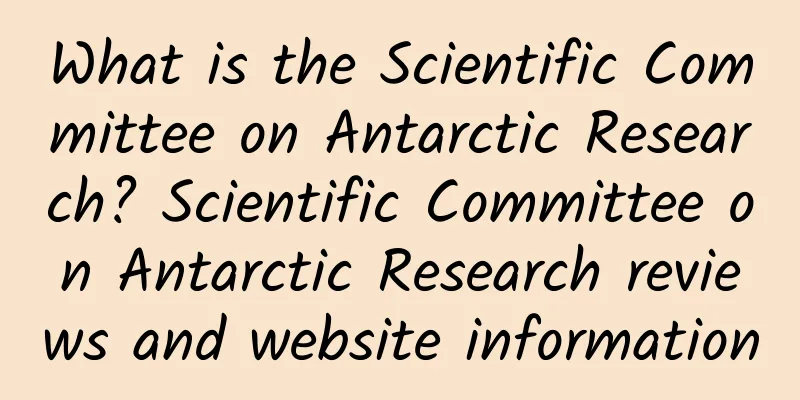What is the Scientific Committee on Antarctic Research? Scientific Committee on Antarctic Research reviews and website information

|
What is the Scientific Committee on Antarctic Research website? The Scientific Committee on Antarctic Research (SCAR) is an organization under the International Council for Science. It was established in 1958 and is mainly responsible for the initiation, development and coordination of scientific research in Antarctica. Website: scar.org Scientific Committee on Antarctic Research (SCAR): international organization promoting scientific research in AntarcticaThe Scientific Committee on Antarctic Research (SCAR), as an important organization under the International Science Council (ISC), has been committed to scientific research, initiation and development in Antarctica since its establishment in 1958. SCAR has not only played a key role in promoting global understanding of the Antarctic environment and ecosystem, but also played an indispensable role in coordinating the cooperation of scientists from various countries. Its official website scar.org is an important platform for obtaining the latest scientific research results, international cooperation trends and relevant policy information about Antarctica. Background and MissionThe birth of the Scientific Committee on Antarctic Research can be traced back to the International Geophysical Year (IGY) of 1957-1958. During this period, scientists from around the world united for the first time to carry out large-scale scientific expeditions in Antarctica. The success of IGY demonstrated the great potential of multinational cooperation in polar scientific research, and also revealed the challenges and opportunities facing Antarctica as a unique and fragile ecosystem. Against this background, SCAR was formally established in 1958 to continue and deepen research work in Antarctica. SCAR's mission is to enhance human understanding of the natural environment, biodiversity and climate change in Antarctica and surrounding areas by initiating, developing and coordinating scientific research in and around Antarctica. In addition, SCAR is committed to providing scientific evidence for the protection of Antarctica and its ecosystems and supporting policy formulation and implementation under the Antarctic Treaty system. Through these efforts, SCAR hopes to ensure that Antarctica can be explored and used in a sustainable manner while minimizing the impact of human activities on its environment. Organizational structure and operation modeSCAR is an independent non-governmental organization composed of scientists from all over the world, including representatives from dozens of countries. These countries are not only major participants in Antarctic scientific research, but also contracting parties to the Antarctic Treaty system. SCAR's highest decision-making body is the General Assembly, which is usually held every two years and is responsible for reviewing and approving the organization's strategic direction, budget and major decisions. In addition to the conference, SCAR also has several specialized committees and working groups responsible for research and coordination in specific areas. For example, the Biological Sciences Committee focuses on Antarctica's biodiversity and its response to climate change; the Geoscience Committee focuses on topics such as the Antarctic continent's geological structure, glacial movement, and paleoclimate records. In addition, SCAR also regularly organizes international seminars and conferences to provide scientists with opportunities to exchange research results and share experiences. SCAR's operating funds mainly come from donations from member countries, support from international cooperation projects, and funding from some private foundations. This diversified funding source enables SCAR to maintain its independence and academic freedom without relying on a single country or organization. Core areas and research resultsAs a leader in Antarctic scientific research, SCAR has made remarkable achievements in many fields. The following are some of the core research areas and their representative results:
SCAR’s research results are not only published in top scientific journals, but are also made available to the public through its official website , scar.org , allowing more people to understand Antarctica’s scientific value and its key role in global environmental change. Website Features and ResourcesVisit scar.org , users can find a wealth of resources and information, covering everything from the latest scientific research to historical archives. Here are some of the main features and functions of the site:
Through these functions and services, the SCAR website not only becomes a platform for scientists to obtain information and carry out their work, but also opens a door for the general public to scientific research in Antarctica. International Cooperation and PartnershipsAs an international organization, SCAR attaches great importance to cooperation with other institutions and groups. It maintains close ties with UNESCO, the World Meteorological Organization (WMO) and several regional scientific organizations. In addition, SCAR also actively participates in the Global Climate Observing System (GCOS) and other related initiatives to contribute wisdom and strength to solving global environmental problems. SCAR's cooperation network also includes many universities, research institutions and non-governmental organizations. By establishing partnerships, SCAR is able to integrate resources from all parties, expand the scale of research, and improve the quality of research. For example, SCAR's cooperation with the British Antarctic Survey (BAS) and the National Science Foundation (NSF) has enabled many large-scale scientific research projects to be successfully implemented. Future Prospects and ChallengesAlthough SCAR has made many achievements in the past few decades, it still faces many challenges. First, with the intensification of global climate change, the ecological environment of Antarctica is undergoing unprecedented changes. How to accurately monitor and predict these changes has become one of the priority issues that SCAR needs to solve. Secondly, due to the remote geographical location and harsh environment of Antarctica, conducting field research is often costly and risky. Therefore, SCAR must continue to innovate research methods and technical means to overcome these difficulties. In addition, with the increase of tourism and resource development activities in Antarctica, the task of protecting the environment in the region has become more urgent. SCAR will continue to play its role as a scientific advisor, providing technical support and advice to the Antarctic Treaty system and other related mechanisms. At the same time, SCAR will further strengthen public education and publicity work to attract more attention and support for scientific research and environmental protection in Antarctica. Looking ahead, SCAR plans to continue expanding its research areas, especially in the application of emerging technologies. For example, artificial intelligence, big data analysis, and drone technology are expected to bring new breakthroughs to Antarctic research. Through these efforts, SCAR hopes to reveal the mysteries of Antarctica more comprehensively and provide a scientific basis for addressing global environmental challenges. ConclusionAs the core driving force of Antarctic scientific research, the Scientific Committee on Antarctic Research (SCAR) not only enjoys a high reputation in the academic community, but also plays an important role in global environmental protection. Its official website scar.org is not only a window to obtain the latest scientific research results and dynamics, but also a bridge connecting scientists, policymakers and the public. By continuously deepening international cooperation, innovating research methods and strengthening public participation, SCAR will continue to contribute to mankind's better understanding and protection of Antarctica. |
<<: What is King's College Hospital like? King's College Hospital reviews and website information
>>: How is Gadjah Mada University? Gadjah Mada University reviews and website information
Recommend
How to soak green fruit in water? The correct way to soak green fruit in water
Green fruit is the mature fruit of the olive tree...
Steps to cook lentils with oyster sauce and mushrooms
Today I will tell you how to make oyster sauce, m...
The efficacy and function of orchids
Orchid is a precious flower and it also has good ...
The efficacy and function of dried passion fruit shell
Dried passion fruit shell is a kind of material o...
The efficacy and function of dwarf cherry
Have you ever seen the dwarf cherry plant? Do you...
What is Hunter Douglas like? Hunter Douglas reviews and website information
What is Hunter Douglas? Hunter Douglas NV is a Dut...
What is The Belize Times like? The Belize Times review and website information
What is the Belize Times website? The Belize Times...
How to make pine nut corn? How to make pine nut corn at home
In the hot summer, you can’t eat anything to get ...
What is Las Vegas Sands like? Las Vegas Sands reviews and website information
What is the website of Las Vegas Sands? Las Vegas ...
The difference between purple dendrobium and candidum
Both Dendrobium officinale and Dendrobium purpuro...
The efficacy and function of pine red plum
Pine Red Plum is an evergreen shrub native to col...
The efficacy and function of black rice porridge
Black rice porridge, as the name implies, is porr...
Nutritional value of green beans
We all know that green beans are a kind of daily ...
How to make lotus seed porridge? Ingredients and steps for making lotus seed porridge
Lotus seeds are a special ingredient that can cle...
What are the benefits of raspberries for women?
Raspberry is a red berry, which comes from the pl...









